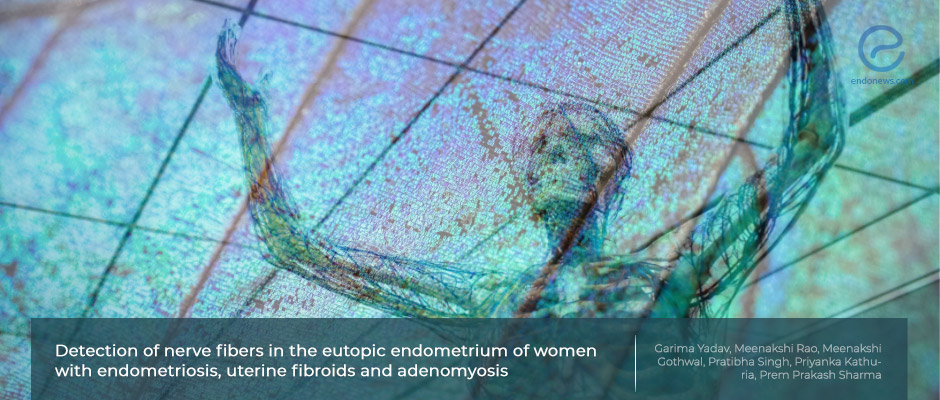Is the presence of nerve fibers in the endometrium associated with endometriosis?
Aug 18, 2021
The detection of nerve fibers in the endometrium might be used as a diagnostic tool in endometriosis, study suggests
Key Points
Highlight:
- Nerve fiber detection might be a less invasive alternative method in patients with a suspected diagnosis of endometriosis.
Importance
- The gold standard in endometriosis diagnosis is the histopathological examination of the tissue obtained by laparoscopy.
- Nerve fiber detection in biopsies and curetting might be a useful method in diagnosing endometriosis.
What’s done here?
- This is a prospective study performed on women with chronic pelvic pain and dysmenorrhea who had a diagnosis of endometriosis, adenomyosis, and uterine fibroids.
- 190 patients with histopathological diagnosis of endometriosis, adenomyosis, or uterine fibroids and 30 patients with dysmenorrhea but did not have the aforementioned diagnoses were included.
- The neuronal marker "PGP 9.5" was used for the immunohistochemical detection and density evaluation of nerve fibers.
- The visual analog scale was used for evaluating the pain score, and these two variables were statistically analyzed.
Key results:
- The nerve fibers were detected in 55.4% of the women with endometriosis; 13.7% in adenomyosis and 3.3% in patients with fibroids.
- These nerve fibers were especially located in the deep layer of the functional endometrium.
- There was no correlation between the stage of endometriosis and the presence of nerve fibers.
- The severity of dysmenorrhea was correlated with the presence of nerve fibers.
- There was a significant correlation between the pain score of the patients and the nerve fiber density.
Lay Summary
Endometriosis is a common disease in reproductive women and diagnostic imaging have a limited role in its diagnosis. The gold standard diagnostic method remains to be the histopathological examination of the tissue obtained via laparoscopy. One of its most common symptoms is pain and the pain generation pathways are still not well understood.
Researchers from All India Institute of Medical Sciences, Jodhpur, India performed a prospective study to detect the nerve fibers in patients who presented with chronic pelvic pain or dysmenorrhea and to discover if this technique could be used in endometriosis diagnosis. The study was published in the June issue of "Obstetrics & Gynecology Science".
The study included 190 patients with a histopathological diagnosis of endometriosis, adenomyosis, or uterine fibroids and 30 patients who underwent hysterectomy for dysmenorrhea but did not have the any of these diagnoses. The protein gene product 9.5 (PGP 9.5) which is a specific neuronal marker and detects sensory nociceptive neurons, was used in the immunohistochemical detection. The visual analog scale was used for pain score and the density of nerve fibers in the endometrium were statistically compared.
The nerve fibers were detected in 55.4% of women with endometriosis, while this rate was only 13.7% in adenomyosis and 3.3% in patients with fibroids. The authors stated that the nerve fiber detection sensitivity in the endometrium is the highest (67.39%) in the setting of a deep endometrial biopsy and it is also highly specific (92.7%).
A couple of studies in the literature concluded that the presence of nerve fibers in the eutopic and ectopic endometrium might be useful in the diagnosis of endometriosis and that the pain intensity was correlated with the density of these nerve fibers. Therefore the authors concluded by saying that a matched case-control study with more biomarkers is needed to ensure the usage of them in endometriosis diagnosis.
Research Source: https://pubmed.ncbi.nlm.nih.gov/34154045/
endometriosis adenomyosis PGP 9.5 nerve fibers nerve fiber detection diagnosis

